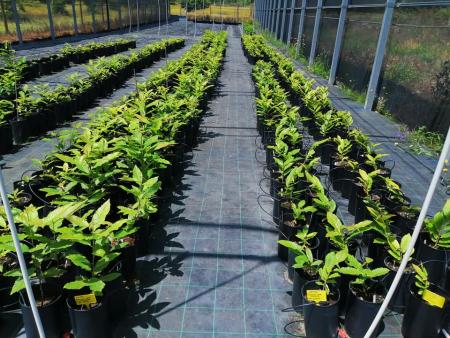
Objective:
European chestnut has a great economic impact in the rural economy of mountainous regions of southwest Europe. The main threats for this important crop are pests and diseases, being the most important root rot, blight disease and gall wasp. Root rot, caused by Phytophthora cinamomi (Pc), is the most severe disease which impact negatively the production of chestnut orchards, which are important for its edible nuts.
The main objective is to release a new product to the market: new genotypes with improved resistance to Pc, selected from the breeding program on course, to be used as rootstocks, with compatibility with nut varieties.
Context:
In order to improve the resistance of chestnut to Phytophthora cinnamomi, and consequently increase the productivity of chestnut orchards, INIAV initiated in 2006 a breeding program based on controlled crosses, using Asian species, namely Castanea crenata and C. mollissima as donors of resistance. The objective was the introgression of resistance genes of Asian species into the susceptible C. sativa, and to create a segregating progeny to identify QTLs and candidate genes for molecular assisted selection, and also to select genotypes with improved resistance to the pathogen.
Contacts:
Rita Lourenço Costa, rita.lcosta@iniav.pt, www.iniav.pt, https://orcid.org/0000-0001-9503-6126
Further information:
1 – Santos C, Machado H, Correia I, Gomes F, Gomes-Laranjo J e Costa R (2014) - Phenotyping Castanea hybrids for Phytophthora cinnamomi resistance. Plant Pathology doi: 10.1111/ppa.12313.
2 - Santos C, Nelson CD, Zhebentyayeva T, Machado H, Gomes-Laranjo J, Costa RL (2017) First interspecific genetic linkage map for Castanea sativa x Castanea crenata revealed QTLs for resistance to Phytophthora cinnamomi. PLoS ONE 12(9): e0184381. https://doi.org/10.1371/journal.pone.018438
3 - Santos C, Duarte S, Tedesco S, Fevereiro P e Costa Lourenço R (2017) Expression profiling of Castanea genes during resistant and susceptible interactions with the oomycete pathogen Phytophthora cinnamomi reveal possible mechanisms of immunity. Frontiers in Plant Science, doi: 10.3389/fpls.2017.00515